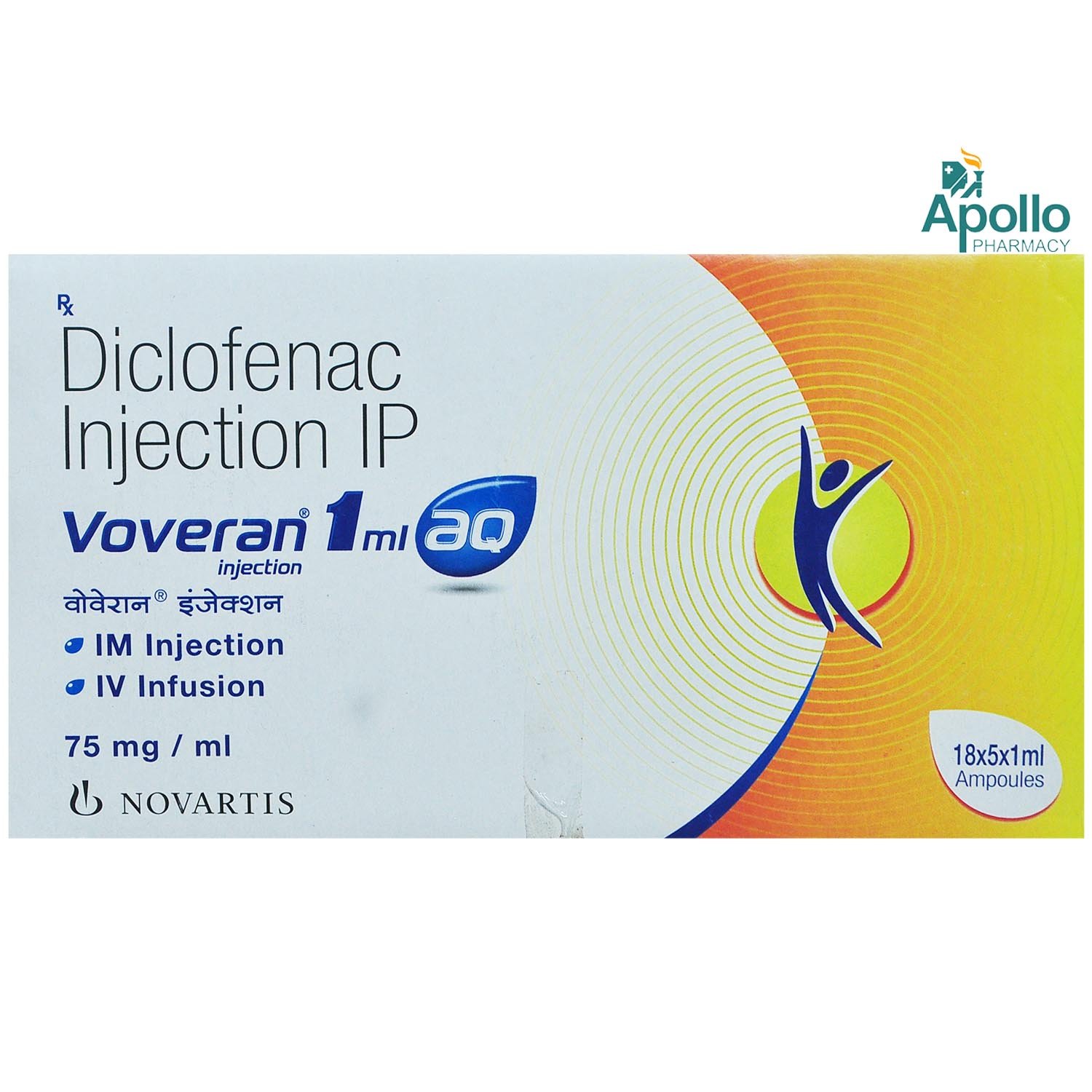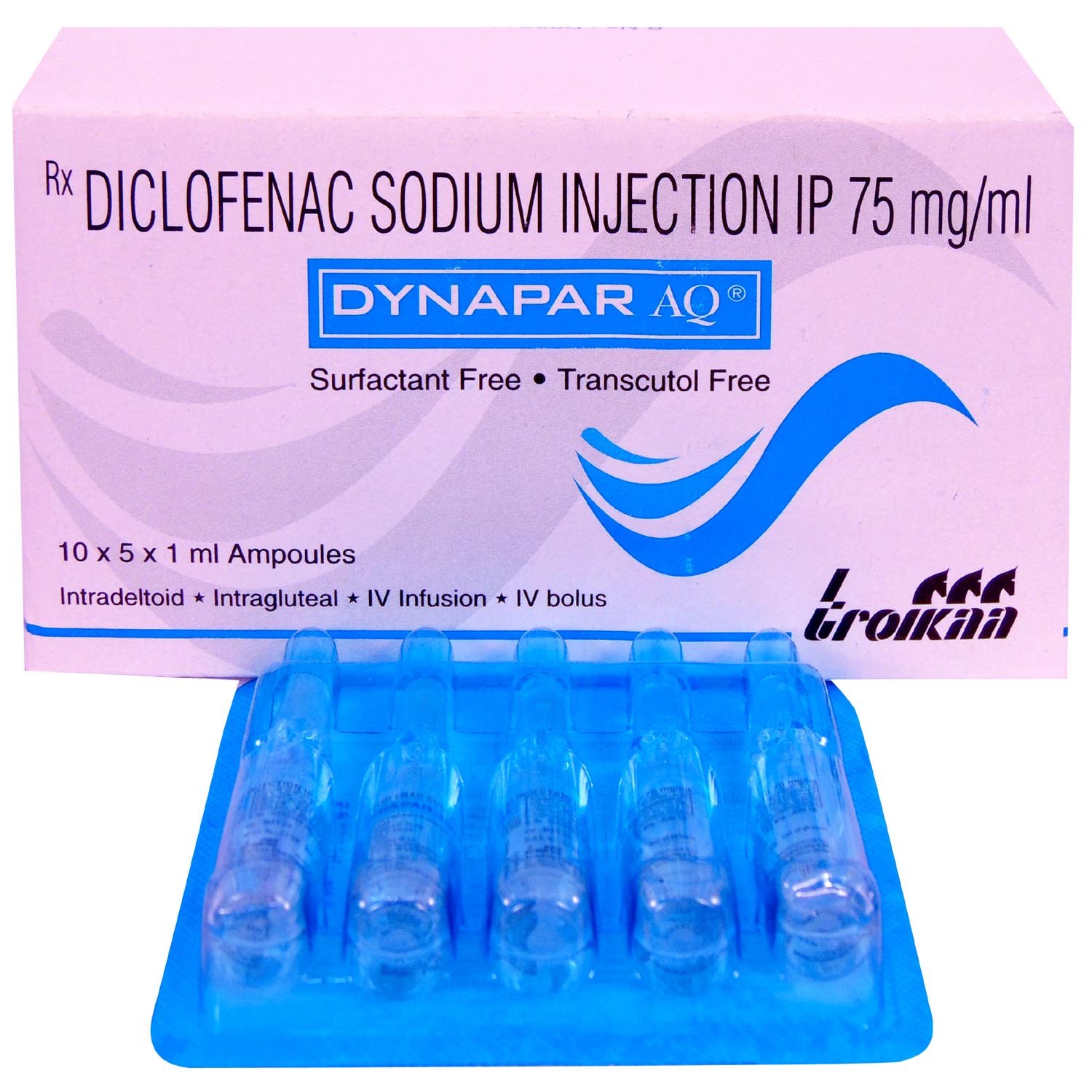Aquadol Injection 1 ml


MRP ₹31.5
(Inclusive of all Taxes)
₹4.7 Cashback (15%)
Provide Delivery Location
Online payment accepted
 Prescription drug
Prescription drugWhats That
Composition :
Manufacturer/Marketer :
Consume Type :
Expires on or after :
Return Policy :
About Aquadol Injection 1 ml
Aquadol Injection 1 ml belongs to a group of medicines called Non-Steroidal Anti-Inflammatory Drugs (NSAID) used to relieve pain in conditions such as flare-ups of joint and back pain, attacks of gout, pain caused by gall stones, kidney stones, injuries, trauma, fractures and pain following surgery.
Aquadol Injection 1 ml contains ‘Diclofenac’, which works by inhibiting the synthesis of certain chemical messengers which are responsible for causing pain and inflammation. Thereby, Aquadol Injection 1 ml helps provide relief from pain.
Aquadol Injection 1 ml may cause common side effects such as stomach pain, nausea, vomiting, heartburn, and injection site reactions. Most of these side effects do not require medical attention and will resolve gradually over time. However, you are advised to talk to your doctor if the side effects persist or worsen.
Aquadol Injection 1 ml is not recommended during the last three months of pregnancy and for children. Inform your doctor if you are pregnant or breastfeeding before receiving this injection. Keep your doctor informed about your health condition and ongoing medicines to rule out any side effects/interactions.
Uses of Aquadol Injection 1 ml
Directions for Use
Key Benefits
Aquadol Injection 1 ml belongs to a group of medicines called Non-Steroidal Anti-Inflammatory Drugs (NSAID) used to relieve pain in conditions such as flare-ups of joint and back pain, attacks of gout, pain caused by gall stones, kidney stones, injuries, trauma, fractures and pain following surgery. Aquadol Injection 1 ml contains ‘Diclofenac’, which works by inhibiting the synthesis of certain chemical messengers responsible for causing pain and inflammation. Thereby, Aquadol Injection 1 ml helps provide relief from pain.
Storage
- Hydrate your body: Drink enough water to prevent dehydration and headaches.
- Calm Your Mind: Deep breathing and meditation can help you relax and relieve stress.
- Rest and Recharge: Sleep for 7-8 hours to reduce headache triggers.
- Take rest: lie down in a quiet, dark environment.
- Cold or warm compresses can help reduce tension.
- Stay Upright: Maintain good posture to keep symptoms from getting worse.
- To treat headaches naturally, try acupuncture or massage therapy.
- Over-the-counter pain relievers include acetaminophen and ibuprofen.
- Prescription Assistance: Speak with your doctor about more substantial drug alternatives.
- Severe Headaches: Seek emergency medical assistance for sudden, severe headaches.
- Frequent Headaches: If you get reoccurring headaches, consult your doctor.
- Headaches with Symptoms: Seek medical attention if your headaches include fever, disorientation, or weakness.
- Inform your doctor about dizziness symptoms. They may adjust your medication regimen or prescribe additional medications to manage symptoms.
- Follow your doctor's instructions for taking medication, and take it at the same time every day to minimize dizziness.
- When standing up, do so slowly and carefully to avoid sudden dizziness.
- Avoid making sudden movements, such as turning or bending quickly, which can exacerbate dizziness.
- Drink plenty of water throughout the day to stay hydrated and help alleviate dizziness symptoms.
- If you're feeling dizzy, sit or lie down and rest until the dizziness passes.
- Track when dizziness occurs and any factors that may trigger it, and share this information with your doctor to help manage symptoms.
Drug Warnings
Do not take Aquadol Injection 1 ml if you are allergic to any of its components; if you have/had gastric/peptic ulcer, active gastrointestinal bleeding, or coronary artery bypass graft surgery. Inform your doctor if you have/had heart problems, liver or kidney problems, heart attack, stroke, blood circulation problems, bowel disorders, bleeding problems, asthma, porphyria, angina, high blood pressure, high levels of fat, diabetes, or Lupus. Consult your doctor if you are pregnant or breastfeeding. Let your doctor know if you are taking any other medicines or supplements. NSAIDs may increase the risk of cardiovascular events, stroke, myocardial infarction, gastrointestinal bleeding, perforation, and ulceration. Hence, caution should be exercised.
Drug-Drug Interactions
Drug-Drug Interactions
Login/Sign Up
Co-administration of Aquadol Injection 1 ml with Meloxicam can increase the risk or severity of gastrointestinal side effects.
How to manage the interaction:
Taking Meloxicam with Aquadol Injection 1 ml is not recommended as it can possibly result in an interaction, it can be taken if your doctor has advised it. However, consult your doctor immediately if you experience symptoms such as dizziness, lightheadedness, red or black, tarry stools, coughing up or vomiting fresh or dried blood that looks like coffee grounds, severe headache, and weakness. Do not stop any medication without doctor's advise.
Taking Aquadol Injection 1 ml with Enoxaparin can increase the risk of bleeding complications.
How to manage the interaction:
There may be a possible interaction between Aquadol Injection 1 ml and Enoxaparin, but they can be taken together if your doctor has prescribed them. However, consult your doctor immediately if you experience any unusual bleeding or bruising, swelling, vomiting, blood in your urine or stools, headache, dizziness, or weakness. Do not discontinue any medications without consulting a doctor.
Coadministration of Aquadol Injection 1 ml with Ketoconazole may increase the risk of liver problems.
How to manage the interaction:
There may be a possible interaction between Aquadol Injection 1 ml and Ketoconazole, but they can be taken together if a doctor has prescribed them. However, consult a doctor immediately if you have fever, chills, joint pain or swelling, unusual bleeding or bruising, skin rash, itching, loss of appetite, fatigue, nausea, vomiting, abdominal pain, dark colored urine, light colored stools, and/or yellowing of the skin or eyes. Do not discontinue any medications without consulting a doctor.
Taking Aquadol Injection 1 ml with human immunoglobulin may increase the risk of kidney problems.
How to manage the interaction:
Although there is an interaction between Human immunoglobulin and Aquadol Injection 1 ml, you can take these medicines together if prescribed by a doctor. However, consult the doctor immediately if you experience symptoms such as nausea, vomiting, loss of appetite, increased or decreased urination, sudden weight gain or weight loss, fluid retention, swelling, shortness of breath, muscle cramps, tiredness, weakness, dizziness, confusion, and irregular heart rhythm. Do not discontinue any medications without consulting a doctor.
Taking Aquadol Injection 1 ml with Ibrutinib can increase the risk of bleeding tendencies.
How to manage the interaction:
There may be a possible interaction between Aquadol Injection 1 ml and Ibrutinib, but they can be taken together if a doctor has prescribed them. However, consult a doctor immediately if you experience any unusual bleeding, dizziness, lightheadedness, red or black, tarry stools, coughing up or vomiting fresh or dried blood that looks like coffee grounds, or severe headaches. Do not discontinue any medications without consulting a doctor.
Co-administration of Aquadol Injection 1 ml with Celecoxib may increase the risk of stomach bleeding and ulcers.
How to manage the interaction:
Although there is a interaction between Aquadol Injection 1 ml and Celecoxib, but it can be taken if your doctor has advised it. Consult a doctor if you experience symptoms like blood in your urine or stool (or a black stool), severe bruising, prolonged nosebleeds, feeling dizzy or lightheaded, weakness or severe headache, vomiting blood or coughing up blood, heavy menstrual bleeding (in women), difficulty breathing, or chest pain. Do not discontinue any medication without consulting a doctor.
Co administration of Aquadol Injection 1 ml with Leflunomide may result in liver problems.
How to manage the interaction:
Co-administration of Aquadol Injection 1 ml and Leflunomide can lead to an interaction; it can be taken if advised by your doctor. However, if you have a fever, chills, joint pain or swelling, unusual bleeding or bruising, skin rash, itching, loss of appetite, fatigue, nausea, vomiting, abdominal pain, dark-colored urine, light-colored stools, or yellowing of the skin or eyes. Do not stop using any medication without consulting your doctor.
Concomitant administration of Aquadol Injection 1 ml and furosemide may decrease the therapeutic efficacy of furosemide and adversely affect renal function.
How to manage the interaction:
There may be a possible interaction between Aquadol Injection 1 ml and furosemide, but they can be taken together if your doctor has prescribed them. However, consult your doctor immediately if you experience symptoms like nausea, dizziness, irregular heartbeats, altered blood pressure, tingling. Do not stop using any medications without first talking to your doctor.
Co-administration of Aquadol Injection 1 ml and tenofovir alafenamide may cause kidney problems.
How to manage the interaction:
There may be a possible interaction between Aquadol Injection 1 ml and Tenofovir alafenamide but they can be taken together if your doctor has prescribed them. However, consult your doctor immediately if you experience symptoms such as such as nausea, vomiting, loss of appetite, increased or decreased urination, sudden weight gain or weight loss, fluid retention, swelling, shortness of breath, bone pain, muscle cramps, tiredness, weakness, dizziness, confusion, and irregular heart rhythm. Do not stop using any medications without talking to your doctor.
Taking Dasatinib together with Aquadol Injection 1 ml may increase the risk of bleeding.
How to manage the interaction:
There may be a possible interaction between Aquadol Injection 1 ml and Dasatinib but they can be taken together if a doctor has prescribed them. However, consult a doctor immediately if you experience dizziness, red or black, tarry stools, or severe headaches. Do not discontinue any medications without consulting a doctor.
Drug-Food Interactions
Drug-Food Interactions
Login/Sign Up
Diet & Lifestyle Advise
- Exercising regularly helps in muscle stretching so that they are less likely to spasm, tear and sprain. Mild exercises such as jogging and walking are helpful for muscle stretching.
- Massages can also be helpful.
- Avoid freezing and hot temperatures.
- Avoid wearing tight-fitting clothes; instead, wear loose garments.
- Rest and sleep well.
- To avoid developing pressure sores, change your position at least every two hours.
- Stay hydrated, and drink plenty of water.
Side Effects of Aquadol Injection 1 ml
- Injection site reactions
- Stomach pain
- Heartburn
- Nausea
- Vomiting
Habit Forming
Therapeutic Class
All Substitutes & Brand Comparisons
RX
Out of StockAvdec 75mg Injection
Aventura Healthcare Pvt Ltd
₹14.7
(₹6.62/ 1ml)
76% CHEAPERRX
Out of StockAverflam 75mg Injection
Altrawell Biotech Pvt Ltd
₹14.3
(₹12.87/ 1ml)
54% CHEAPERRX
Out of StockAsradic 75mg Injection
₹14.9
(₹13.41/ 1ml)
52% CHEAPER
Product Substitutes
Author Details
We provide you with authentic, trustworthy and relevant information
Drug-Diseases Interactions
Drug-Diseases Interactions
Login/Sign Up
FAQs
Aquadol Injection 1 ml works by inhibiting the synthesis of certain chemical messengers responsible for causing pain and inflammation. Thereby, Aquadol Injection 1 ml helps provide relief from pain.
Concomitant use of Aquadol Injection 1 ml with aspirin is not recommended as it may cause increased gastrointestinal bleeding. Consult your doctor if you have any concerns.
Aquadol Injection 1 ml might make it more difficult to conceive. Therefore, please consult your doctor if you are planning to become pregnant or have problems getting pregnant.
Drug-Drug Interactions Checker List
- WARFARIN
- LITHIUM
- METHOTREXATE
- CICLOSPORIN
- TACROLIMUS
- TRIMETHOPRIM
- MIFEPRISTONE
- VORICONAZOLE
- PHENYTOIN
- CHOLESTYRAMINE
Disease/Condition Glossary
Pain: Pain is a symptom triggered by the nervous system, causing uncomfortable sensations in the body. Pain may be dull or sharp; it might be constant or may come and go. The tolerance level of pain might vary from person to person. Pain can be generalized (overall body aches) or localized (affecting a specific area of the body). The common causes of pain include headache, muscle strain, cramps, fractures, arthritis, and injury.

Have a query?
Buy best C.n.s Drugs products by
Intas Pharmaceuticals Ltd
Sun Pharmaceutical Industries Ltd
Torrent Pharmaceuticals Ltd
Alkem Laboratories Ltd
Abbott India Ltd
Cipla Ltd
Alteus Biogenics Pvt Ltd
Micro Labs Ltd
Lupin Ltd
Ipca Laboratories Ltd
D D Pharmaceuticals Pvt Ltd
Icon Life Sciences
Mankind Pharma Pvt Ltd
Tripada Healthcare Pvt Ltd
Arinna Lifesciences Ltd
Linux Laboratories Pvt Ltd
East West Pharma India Pvt Ltd
La Renon Healthcare Pvt Ltd
Talent India Pvt Ltd
Tas Med India Pvt Ltd
Zydus Healthcare Ltd
Cnx Health Care Pvt Ltd
Eris Life Sciences Ltd
Leeford Healthcare Ltd
Emcure Pharmaceuticals Ltd
Macleods Pharmaceuticals Ltd
Sigmund Promedica
Aristo Pharmaceuticals Pvt Ltd
Dr Reddy's Laboratories Ltd
Troikaa Pharmaceuticals Ltd
Consern Pharma Ltd
Zydus Cadila
Shine Pharmaceuticals Ltd
Wockhardt Ltd
Ardent Life Sciences Pvt Ltd
Crescent Formulations Pvt Ltd
Theo Pharma Pvt Ltd
Reliance Formulation Pvt Ltd
Ikon Pharmaceuticals Pvt Ltd
Propel Healthcare
Neon Laboratories Ltd
Jagsam Pharma
Msn Laboratories Pvt Ltd
Morepen Laboratories Ltd
Pulse Pharmaceuticals
Sanofi India Ltd
Med Manor Organics Pvt Ltd
Hetero Healthcare Pvt Ltd
Novartis India Ltd
Crescent Therapeutics Ltd
Elder Pharmaceuticals Ltd
Solvate Laboratories Pvt Ltd
Akumentis Healthcare Ltd
Mova Pharmaceutical Pvt Ltd
Psyco Remedies Ltd
Tripada Lifecare Pvt Ltd
Ajanta Pharma Ltd
Cyrus Remedies Pvt Ltd
Medishri Healthcare Pvt Ltd
Cadila Healthcare Ltd
Glenmark Pharmaceuticals Ltd
Matteo Health Care Pvt Ltd
Hbc Life Sciences Pvt Ltd
Lyf Healthcare
Matias Healthcare Pvt Ltd
Mesmer Pharmaceuticals
Alembic Pharmaceuticals Ltd
Capital Pharma
Crescent Pharmaceuticals
Medopharm Pvt Ltd
Alniche Life Sciences Pvt Ltd
Kivi Labs Ltd
Talin Remedies Pvt Ltd
USV Pvt Ltd
Quince Lifesciences Pvt Ltd
Solis Pharmaceuticals
Infivis Life Care
Zuventus Healthcare Ltd
Cadila Pharmaceuticals Ltd
Pfizer Ltd
Wallace Pharmaceuticals Pvt Ltd
A N Pharmacia Laboratories Pvt Ltd
Blue Cross Laboratories Pvt Ltd
Jenburkt Pharmaceuticals Ltd
Lia Life Sciences Pvt Ltd
Mano Pharma
Medley Pharmaceuticals Ltd
Primus Remedies Pvt Ltd
FDC Ltd
Maneesh Pharmaceuticals Ltd
Apex Laboratories Pvt Ltd
Gagnant Healthcare Pvt Ltd
Ozone Pharmaceuticals Ltd
RPG Life Sciences Ltd
Strides Shasun Ltd
Unichem International
GlaxoSmithKline Pharmaceuticals Ltd
Kuresys Labs Pvt Ltd
LA Pharma
Trion Pharma India Llp
Alcohol
Safe if prescribed
It is not known if alcohol affects Aquadol Injection 1 ml. Please consult your doctor for more information. However, limiting alcohol consumption is recommended while on treatment with Aquadol Injection 1 ml.
Pregnancy
Consult your doctor
Aquadol Injection 1 ml is not recommended for use in the last three months of pregnancy as it may harm the unborn child or cause problems at delivery. Hence, if you are pregnant or planning pregnancy, inform your doctor before receiving Aquadol Injection 1 ml. Your doctor may prescribe this medicine if the benefits outweigh the risks.
Breast Feeding
Consult your doctor
If you are breastfeeding, inform your doctor before receiving Aquadol Injection 1 ml. Your doctor may prescribe this medicine if the benefits outweigh the risks.
Driving
Safe if prescribed
Occasionally, Aquadol Injection 1 ml may cause dizziness and tiredness. Drive or operate machinery only if you are alert.
Liver
Consult your doctor
If you have a history of liver disease, inform your doctor before receiving Aquadol Injection 1 ml. Your doctor may adjust the dose of this medicine or prescribe a suitable alternative based on your condition.
Kidney
Consult your doctor
If you have a history of kidney diseases, inform your doctor before receiving Aquadol Injection 1 ml. Your doctor may adjust the dose of this medicine or prescribe a suitable alternative based on your condition.
Children
Safe if prescribed
Aquadol Injection 1 ml is not recommended for children.









_0.jpg?tr=q-85)

